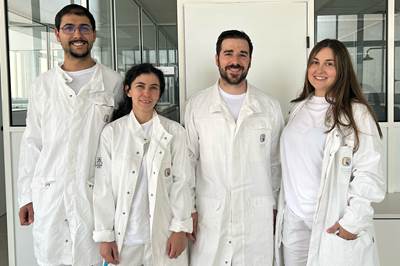UV curing systems save composites curing time, energy
CAMX 2024: IST America presents a comprehensive selection of UV, IR and hot air technologies, designed to deliver results in less than a minute.
Share
Source | IST America
Known for its global design and construction of UV and LED technology, (Shorewood, Ill., U.S.), part of the IST Metz Group, is sharing innovations in its light curing platforms for polymer matrices in composite component production. IST says that the state-of-the-art advancements save significant time and energy while maintaining high quality.
UV curing is a versatile solution for various production processes, including wet layup techniques, vacuum infusion with UV-transparent membranes, filament winding, prepreg processes and continuous flat processes. Unlike traditional thermal curing methods, IST America points out, UV curing delivers optimal results in less than a minute as opposed to hours, cutting cycle time and energy consumption. This also amplifies an industrial process’ sustainability benefits, as it requires only one tool, thus reducing carbon footprint.
A standout benefits of UV formulations is their styrene-free composition. The 1K solutions feature an extended pot life of several months, eliminating the need for complex storage. Additionally, they contain no volatile organic compounds (VOCs), making them environmentally friendly and compliant with strict regulations.
IST America ensures optimal curing results by leveraging various radiation sources and light profiles tailored to specific applications and curing strategies. While the thickness of laminates is limited to approximately one inch for efficient UV application, multi-ayer buildups can be considered, expanding the possibilities for composite designs and providing an alternative for structural composites.
The market offers formulations that facilitate the curing of fiberglass and carbon fiber. These advancements are said to be enhanced by IST America’s expertise in designing and installing customized light sources.
Related Content
-
Hardener accelerator line designed for epoxy resin optimization
CAMX 2024: Alzchem highlights the Dyhard series of latent curing agents, providing the balance of mechanical and thermal properties formulators need for thermoset epoxy resin systems.
-
ITA, Micor GmbH study the potential of in-line infrared drying of glass fiber
Research has shown that, beyond reducing energy consumption and production waste, an integrated, compact infrared module enables uniform sizing distribution on the glass fibers and more efficient production overall.
-
Exploring powder coating for composites
Advancements in powder coating technology make it a viable surface finish for a growing number of composite applications.
Related Content
Hardener accelerator line designed for epoxy resin optimization
CAMX 2024: Alzchem highlights the Dyhard series of latent curing agents, providing the balance of mechanical and thermal properties formulators need for thermoset epoxy resin systems.
Read MoreITA, Micor GmbH study the potential of in-line infrared drying of glass fiber
Research has shown that, beyond reducing energy consumption and production waste, an integrated, compact infrared module enables uniform sizing distribution on the glass fibers and more efficient production overall.
Read MoreExploring powder coating for composites
Advancements in powder coating technology make it a viable surface finish for a growing number of composite applications.
Read MoreEnvironmentally friendly composites polymerization initiator
CAMX 2025: The phthalate- and solvents-free Akperox ST-CL200 presented by AKPA Chemicals provides a reliable, user-friendly polymerization alternative while enabling high-performance production processes.
Read MoreRead Next
EUVAM project investigates energy-efficient UV process for composites curing
University of Stuttgart researchers intend to develop flexible, highly productive and digitally controllable manufacturing approach for small urban vehicle production.
Read MoreKeyland Polymer opens UV-cured solid resin R&D lab in Spain
The new state-of-the-art facility in Barcelona is staffed to grow Keyland’s UV resin R&D, production and sales used in inks, AM, composite powder coatings and other products.
Read MoreScaling up, optimizing the flax fiber composite camper
Greenlander’s Sherpa RV cab, which is largely constructed from flax fiber/bio-epoxy sandwich panels, nears commercial production readiness and next-generation scale-up.
Read More









